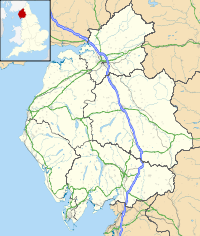- St John's Church, Workington
-
St John's Church, Workington Location in Cumbria Coordinates: 54°38′30″N 3°32′39″W / 54.6417°N 3.5443°W OS grid reference NY 004 285 Location Washington Street, Workington, Cumbria Country England Denomination Anglican Website St John, Workington Architecture Status Parish church Functional status Active Heritage designation Grade II* Designated 6 June 1951 Architect(s) Thomas Hardwick
W. and C. A. Bassett-Smith
Ninian ComperArchitectural type Church Style Neoclassical Specifications Materials Calciferous sandstone
Green slate roofAdministration Parish St John, Workington Deanery Solway Archdeaconry West Cumberland Diocese Carlisle Province York Clergy Vicar(s) Revd John Michael Cook St John's Church, Workington, is located in Washington Street, Workington, Cumbria, England. It is an active Anglican parish church in the deanery of Solway, the archdeaconry of West Cumberland, and the diocese of Carlisle.[1] The church has been designated by English Heritage as a Grade II* listed building.[2] It is a Commissioners' church, having received a grant towards its construction from the Church Building Commission.[3]
Contents
History
St John's was built between 1822 and 1823, and was designed by Thomas Hardwick, originally as a chapel of ease.[2] A grant of £10,488 (£790,000 as of 2011)[4] was given towards its construction by the Church Building Commission.[3] The tower, originally built in wood, was rebuilt in stone in 1847 by Nelson of Carlisle. The altar was originally at the west end, and the church was re-orientated in 1897–99 by W. and C. A. Bassett-Smith, placing the altar at the east end. In 1930–31 this was reverted to its original position by Ninian Comper.[5]
Architecture
Exterior
The church is constructed in hammer-dressed calciferous sandstone with an ashlar plinth, pilasters and eaves. The roof is in green slate.[2] Its architectural style is Neoclassical, and the design is based on that of St Paul's, Covent Garden. The tower and portico are at the east end. The tower is square at the base, then becomes octagonal, with pairs of pilasters, and has a a round cap at the top. The portico is supported by two large columns. Along the sides of the church are tall round-headed windows.[5]
Interior
The interior of the church is in five bays.[2] There is no chancel.[5] There are galleries on three sides of the church, supported on thin fluted cast iron columns. The plaster ceiling is flat, and is decorated with ribbing and coats of arms.[2] At the west end is a completely gilded Italianate baldacchino. This was designed by Comper, as were the cover of the font, the stained glass in the east window, and the organ case, which is in Ionic style.[5] The two manual organ was built in 1905 by Richard Heslop, and was rebuilt in 1961 by Rushworth and Dreaper.[6]
See also
- List of Commissioners' churches in Northeast and Northwest England
References
- ^ St John, Workington, Church of England, http://www.achurchnearyou.com/workington-st-john/, retrieved 19 October 2011
- ^ a b c d e Church of St John and adjoining parish room, Workington (1138257). National Heritage List for England. English Heritage. Retrieved 19 October 2011.
- ^ a b Port, M. H. (2006), 600 New Churches: The Church Building Commission 1818-1856 (2nd ed.), Reading: Spire Books, p. 326, ISBN 978-1-904965-08-4
- ^ UK CPI inflation numbers based on data available from Lawrence H. Officer (2010) "What Were the UK Earnings and Prices Then?" MeasuringWorth.
- ^ a b c d Hyde, Matthew; Pevsner, Nikolaus (2010) [1967], Cumbria, The Buildings of England, New Haven and London: Yale University Press, p. 699, ISBN 978-0-300-12663-1
- ^ Cumberland (Cumbria), Workington, St. John, Washington Street (D00960), British Institute of Organ Studies, http://www.npor.org.uk/cgi-bin/Rsearch.cgi?Fn=Rsearch&rec_index=D00960, retrieved 19 October 2011
External links
Categories:- Grade II* listed buildings in Cumbria
- Grade II* listed churches
- Church of England churches in Cumbria
- Diocese of Carlisle
- 19th-century Anglican church buildings
- Anglican congregations established in the 19th century
- Neoclassical architecture in England
- Commissioners' churches
Wikimedia Foundation. 2010.

